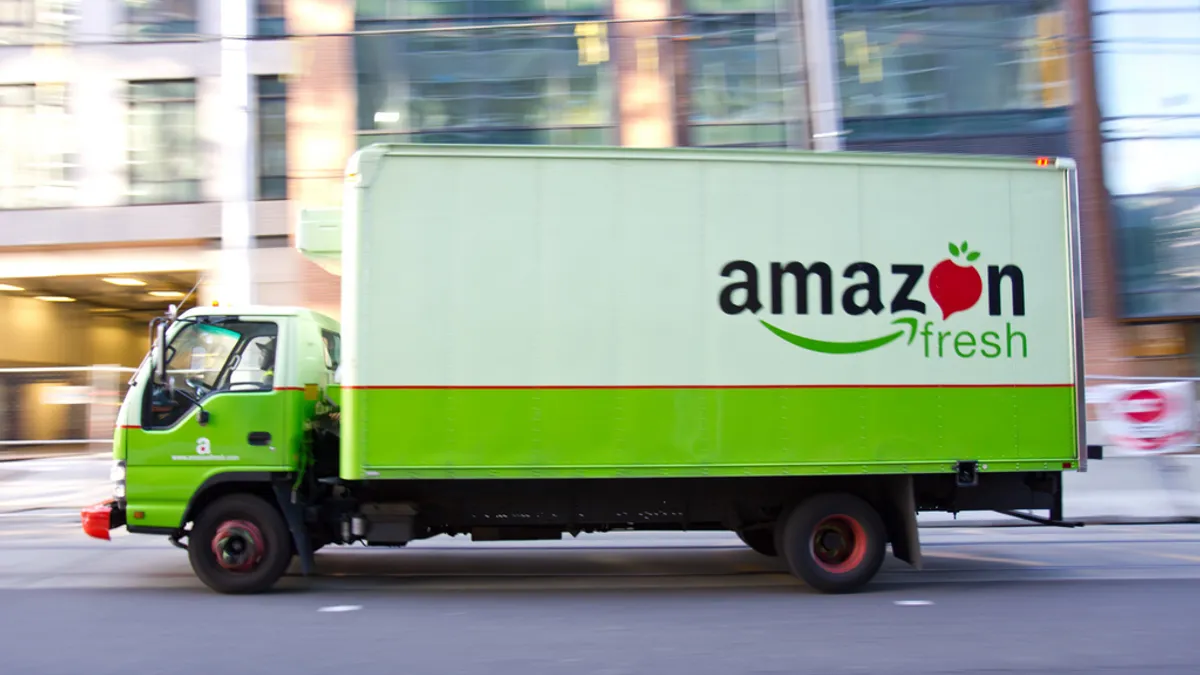Dive Brief:
- Consumables accounted for more than $10 billion of Amazon's sales last year — nearly $5 billion in health and personal care, $3 billion in grocery and $2.5 billion in pet products, according to Edge by Asciential's 2018 review. These low-cost, high-volume household items drive frequent traffic, compared to one-time luxury purchases of expensive electronics.
- In grocery, year-over-year growth dropped 25% as Amazon struggled to capitalize on perishable sales through its Amazon Fresh and Prime Pantry services. Led by $600 million in both coffee and cold drinks, beverages offered a bright spot. Single-use coffee pods dominated over 80% of the coffee segment, while RTD coffee drinks doubled. Corn snacks, seeds and nuts led growth in the latter subset, spiking 90% compared to 2017. Snacks and breakfast foods reached $550 million, up 50% and 15%.
- Vitamins, minerals and supplements now cover half of all health and personal care purchases, gaining 65% from last year, while over-the-counter health remedies jumped 50%. Amazon bought PillPack in 2018, solving the issue of obtaining pharmaceutical licenses across the country, the report says. Household consumables neared $900 million, but baby care took second place in this category with nearly $1 billion in sales.
Dive Insight:
Though the tech giant hasn't yet figured out the fresh side of grocery, it has gained traction as a destination for plenty of products brick-and-mortar stores are known to stock.
A similar report from One Click Retail published last summer discovered the same trends in coffee, cold drinks and snacks, with sales topping $350 million in the second quarter alone. But it seems consumers are turning to Amazon for toiletries and dry foods — crackers, granola bars, nuts and bottled still or canned sparkling water — but rarely for meat or produce. How long that trend can last could depend on whether consumers truly embrace online grocery and how well Amazon plays the private label game. Currently, grocery items comprise only 2% of Amazon's private label portfolio.
Since the online shopping boom, grocers have taken big risks to expand offerings in other departments to encourage one-stop-shopping. Traditional stores should fear the risk inherent in Amazon's growth in those categories, as customers can easily have paper towels, baby wipes, shampoo and toothpaste delivered to their door at no extra charge.
The Ascential report denotes nutrition and wellness, baby care, household consumables and health care as the four main drivers of personal care sales. That list notably omits beauty products, which account for a portion of grocery's $14 billion in health and beauty sales, according to the Food Marketing Institute. Grocery chains have broadened their spectrum of standard makeup and toiletry essentials to include lotions, balms, toothpastes and deodorants made with natural ingredients. Fairway has even launched a private label line of CBD products.
Grocers, including Amazon, have also benefited from people's adoration of their cats and dogs: 67 of the top 100 retailers in the U.S. sell pet food and other pet products, according to Pet Food Industry and a large portion of Amazon's consumable sales comes from pet food. But Petco and PetSmart still lead that pack, reaching $8 billion and $4 billion, respectively, in 2017, while 52% of rural pet owners report satiating their furry friends at Walmart.
Nonetheless, Amazon is leading the online grocery game overall, but Walmart, Target, Kroger and Safeway are trying to close in. Many have added curbside pickup — perhaps the best solution for customers' wariness of Amazon meat and vegetables.












